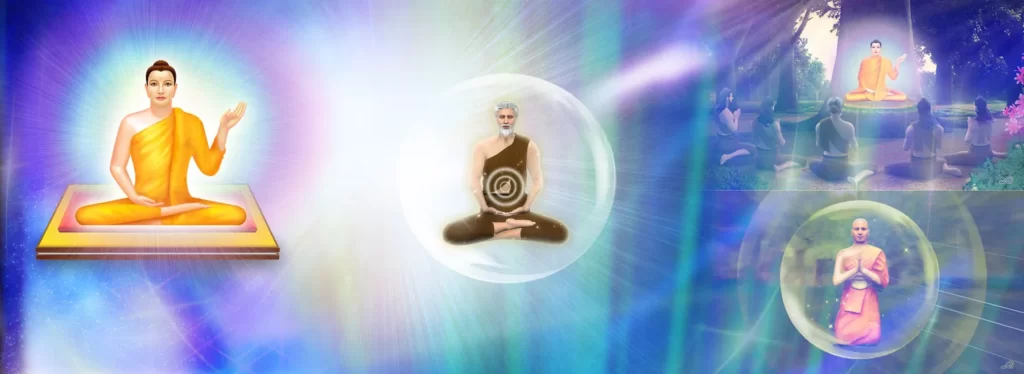
Asalha Puja Day
The Significance of Asalha Puja Day
Asalha Puja Day is an important day in Buddhism. It takes place on the 15th waxing moon day of the 8th lunar month of every year (for this year, it falls on August 1, 2023). It commemorates four important occurrences which took place during the time of the Buddha as follows;
- The Buddha delivered his first sermon. The sermon was delivered to five ascetics at the Isipatanamarugadivan forest near the city of Benares (present day Varanasi, an Indian city on the banks of the Ganga River in Uttar Pradesh).
- The Buddha gained his first disciple. Upon the completion of his sermon, ascetic Kondanna had attained the first state of enlightenment to become a Sotapanna
- It was the day of the first Buddhist monk. After attaining the holy state of Sotapanna, Kondanna asked for the Buddha’s permission to be ordained as a Buddhist monk, for which the Buddha granted. Kondanna thus became the first monk in Buddhism, signifying the beginning of the Sangha, the Order of Monks.
- The establishment of the Triple Gem which includes the Buddha, the Dhamma, and the Sangha or monks. The fact that the Buddha taught his Dhamma to others, had earned him the status of Samma-Sambuddha, a self-enlightened being who teaches his Knowledge to the world (as differed from a Paccekabuddha, who does not teach).

The history of Asalha Puja Day
After the Buddha’s Enlightenment, he spent seven weeks delighting in the bliss of emancipation. Afterwards, he pondered whether or not to teach his enlightened Knowledge to others. He was concerned that the Dhamma that he had discovered was so deep and profound that ordinary humans whose minds were clouded with mental impurities would find it difficult to comprehend.
The Buddha examined all the beings that existed in the cycles of rebirth and saw that humans were different in many ways: some were consumed by defilements, while others were relatively free of them; some possessed a strength of character and virtues, while others were weak in character and virtues; some were easy to teach, while others were difficult to teach.
He likened them to lotus plants in their three stages of growth: First stage: deep beneath the water, not having the capacity to bloom. Second stage: reaching the surface of the water, capable of blooming and Third stage: risen above the water, ready to bloom at any time. Those that were difficult to teach were likened to lotus plants that were immersed deep beneath the water; those that were easy to teach were likened to lotus plants that had risen above the water.
With His great compassion, he then thought of the five ascetics who, during his early years of spiritual quest, had attended to him. So he set out on a journey to see them at the Isipatanamarugadivan forest where they dwelled and later on the Buddha had solved all their concerns and doubts on his enlightenment. All five ascetics were ready to listen to his Dhamma. The Buddha’s first sermon is known as Dhammacakkappavattana Sutta which means the setting in motion of the Wheel of Dhamma. Its teaching encapsulates the Four Noble Truths and the Noble Eightfold Path, regarded as the central doctrine of the Buddhist religion.
After the Buddha completed his sermon, ascetic Kondanna attained the first state of holiness to become a Sotapanna (Stream-enterer). He was subsequently ordained as a Buddhist monk. This event completed the third component of the Triple Gem.

The significance of Dhammacakkappavattana Sutta
In his first sermon, the Buddha advised the ascetics to avoid the following two practices that are unfit for a holy person: Firstly, Indulging in sensual pleasure—this is an impure practice engaged by ordinary people and householders, not for a holy person to pursue. Secondly, Self-mortification—this practice does not lead to spiritual attainment. It produces no benefit. The Buddha encouraged ones to follow The Middle Way, the Way that leads to liberation. This Way encompasses the Noble Eightfold Path and the Four Noble Truths. The Middle Way comprises eight components which can be summarized as Sila (morality), Samadhi (concentration), and Panna (insight). It means having right view, having right resolve, having right speech, having right action, having right livelihood, having right effort, having right mindfulness, and having right concentration. Having successfully practiced the Middle Way, one will gain penetrating knowledge about the Four Noble Truths, which include:
- Suffering: The different forms of suffering include birth, aging, sickness, death, melancholy, grief, longing, frustration, encountering what one hates, being parted from what one loves, not getting what one wants, etc.
- The Cause of Suffering: Craving is the cause of suffering. There are three forms of craving: Craving for sensual pleasures, craving for existence, and craving for self-annihilation.
- The Cessation of Suffering: It is the state where suffering has been extinguished, where no trace of craving remains, where there is liberation.
- The Path Leading to the Cessation of Suffering: It is the Noble Eightfold Path as mentioned earlier. The Noble Eightfold Path is the practice which leads to the penetrating knowledge of the Four Noble Truths.

The significance of the Buddha, the Dhamma and the Sangha
The Triple Gem comprises of the Buddha, the Dhamma and the Sangha. It is the highest state to be respectful in Buddhism and it bestows an immeasurable benefit upon the aspirants who worship the Triple Gem. Such a benefit is incomparable to any worldly treasure or wealth. Thus realization and recollecting the goodness of the Triple Gem yields a steady progressive benefit and happiness, steering the aspirants away from all darkness and illnesses. The Triple Gem in Buddhist terminology refers to:
1. the Buddha
The one who is self-enlightened, having realized the Noble Truths. He is the founder of Buddhism, being perfect in the threefold virtues as follows :
- The Virtue of Wisdom : This implies his Enlightenment through his own efforts, which means the supreme knowledge of all things as they really are. Such Knowledge of his are unchangeable and timeless.
- The Virtue of Purity : His mind is absolutely purified, freed of all passions or darkness, having no desire for nor aversion to anything or anybody, no attachment nor hatred towards all sentient beings.
- The Virtue of Compassion : His compassion is of the purest nature, thereby being unilateral i.e. for the sake of the benefit and happiness of sentient beings themselves. Convinced of how beings are helplessly caught in the ocean of sufferings, He undertook the mission of helping them out of their plight.
2. the Dhamma
The Buddha enlightened discovering the so-called 84,000 Dhamma-khandha (Aggregates or items of Dhamma), He shouldered the task of disseminating parts of the Dhamma of his discovery that would be conducive the happiness, progress, peace and security to all beings. His teachings are based on the listener’s tendencies and maturity, He knew how to teach them parts of the Dhamma that were suited to their capacity for practice. He did this so that they could be blessed with peace, progress and prosperity in their lives.
3. the Sangha
The word Sangha, if translated as a substantive, refers to those who have ordained and are wearing the yellow robe. Translated as a quality, it refers to all people in general who have practiced correctly in line with the Buddha’s teachings. Members of the monastic order, however, are of all sorts, and so we have two groups as follows;
- A.Sammuti-Sangha: The conventional Sangha.
- B.Ariya-Sangha: The Noble Sangha.
Membership in the conventional Sangha is attained through consent of the Order, in a formal ceremony with witnesses, following the procedures set out in the Vinaya. While, membership in the Noble Sangha is attained when the quality of transcendence (Lokuttara Dhamma) appears in one’s heart as a result of one’s own behavior and practice, with no formalities of any sort whatsoever.
All Buddhists – whether formally ordained or not, no matter what their gender, color, or social position – can become members of this Sangha. This is termed being ordained by the Dhamma, or being self-ordained in a way that cannot be faulted.

Asalha Puja Day and World Peace
Buddhism is the peaceful religion which applies Dhamma into our daily lives. Most of Dhamma Teachings are going to make the disciples calm and serene. Moreover, abstaining from all negativities which are greed, anger and delusion.
Thus, Buddhists are peace lovers and they don’t tend to use violence to solve the conflicts or problems. Even the Buddhism propagation is not forcing anybody to believe, while giving an opportunity to those who would like to practice and learn Buddhism by themselves.
Therefore, if all human beings practice the Buddhist Way of Life by purifying their minds with meditation every day, all darkness and evil will be gradually eliminated. The sense of compassion and kindness towards other beings will occur. If so, World Peace will surely happen.
We realized that the Buddha’s Teachings are immensely valuable and important so on Asalha Puja Day, let us all remember and recollect the first sermon of the Buddha which is Dhammacakkappavattana Sutta and let’s meditate to purify our minds and spread our loving kindness to others in order to create World Peace with one another.



